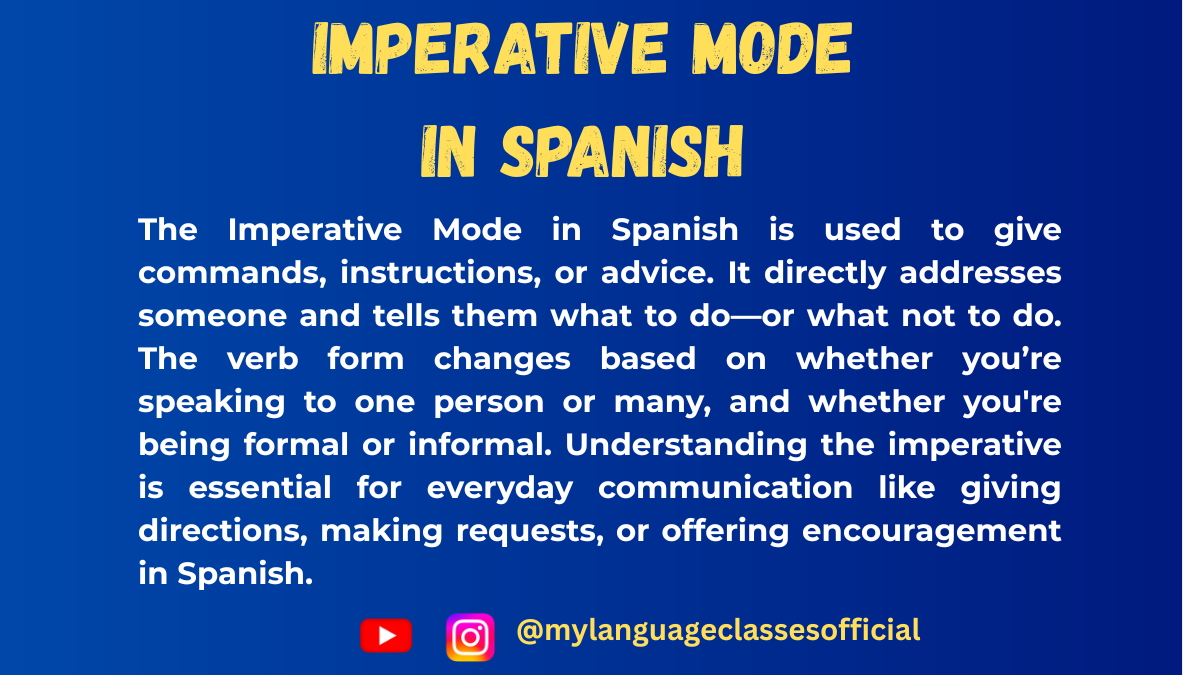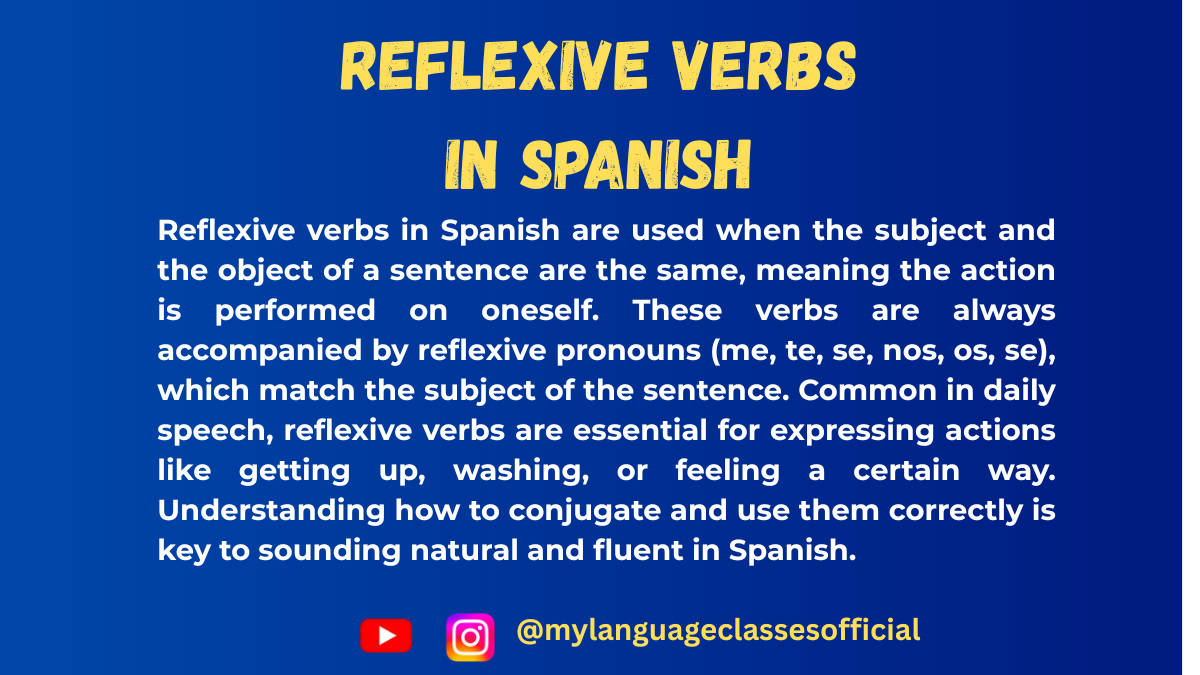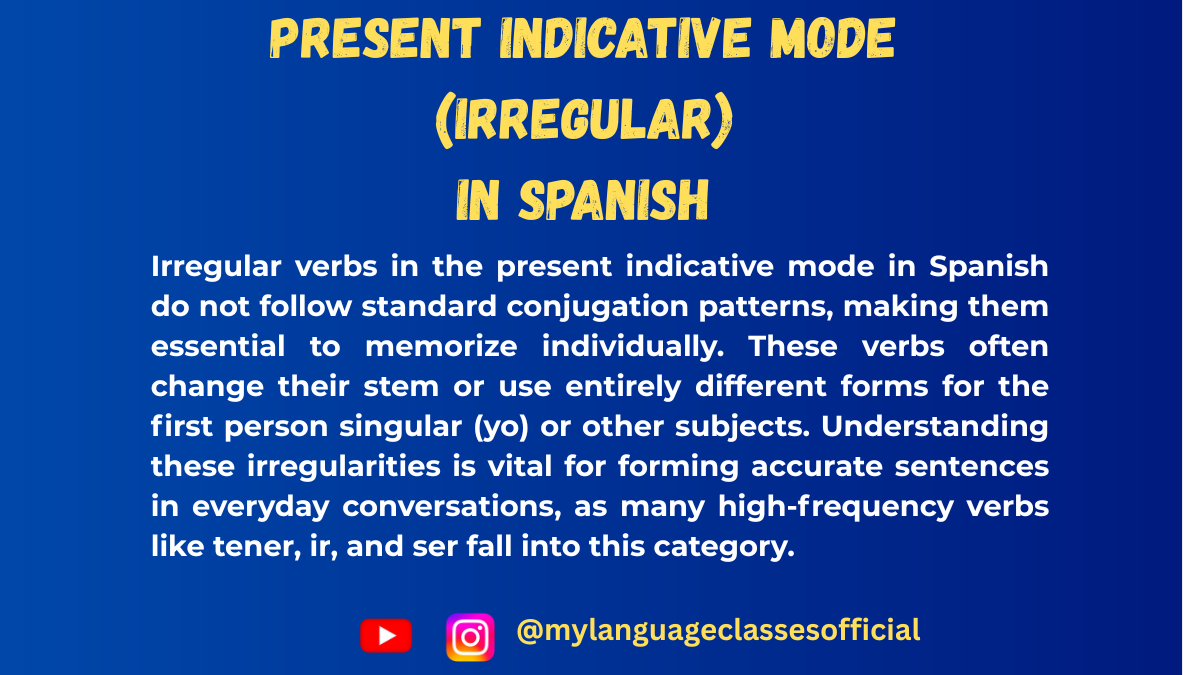Your cart is currently empty!
Category: Verbs in Spanish
Master the use of Spanish verbs with clear lessons on regular and irregular conjugations, verb tenses, moods, and real-life usage. Learn how to express actions and ideas accurately in past, present, and future contexts. Ideal for all learners from beginner to advanced levels.
-
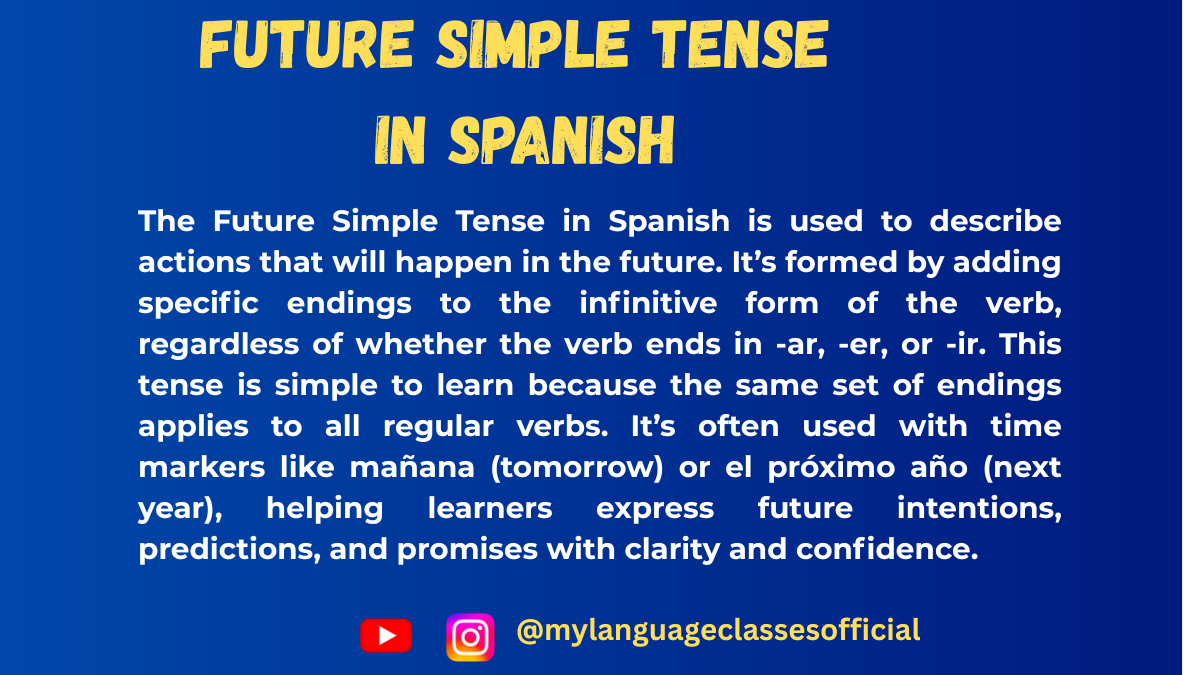
Future Simple Tense in Spanish (Futuro Simple)
Future Simple Tense in Spanish
The Future Simple tense in Spanish is used to talk about actions or events that will happen in the future. It’s an essential tense for expressing plans, predictions, promises, or possibilities. Here, we’ll explore how to form the Future Simple tense, its applications, common verbs, and expressions used in everyday life.
Situations Where the Future Simple Tense is Used
- Expressing Intentions or Plans
- Example: Mañana visitaré a mi abuela.
(Tomorrow, I will visit my grandmother.)
- Example: Mañana visitaré a mi abuela.
- Making Predictions
- Example: Lloverá esta tarde.
(It will rain this afternoon.)
- Example: Lloverá esta tarde.
- Expressing Assumptions or Guesses
- Example: ¿Quién será a la puerta?
(Who might be at the door?)
- Example: ¿Quién será a la puerta?
- Giving Commands in a Polite Way
- Example: Abrirás el libro en la página diez.
(You will open the book on page ten.)
- Example: Abrirás el libro en la página diez.
- Expressing Promises or Determination
- Example: Te llamaré más tarde.
(I will call you later.)
- Example: Te llamaré más tarde.
Forming the Future Simple Tense
In Spanish, the Future Simple tense is formed by adding specific endings to the infinitive form of the verb. The endings are the same for -ar, -er, and -ir verbs.
Regular Verbs
- Endings:
-é, -ás, -á, -emos, -éis, -án
Examples with Regular Verbs:
- Hablar (to talk)
- Yo hablaré (I will talk)
- Tú hablarás (You will talk)
- Él/Ella/Usted hablará (He/She/You formal will talk)
- Nosotros hablaremos (We will talk)
- Vosotros hablaréis (You all will talk)
- Ellos/Ellas/Ustedes hablarán (They/You all formal will talk)
- Comer (to eat)
- Yo comeré (I will eat)
- Tú comerás (You will eat)
- Él/Ella/Usted comerá (He/She/You formal will eat)
- Nosotros comeremos (We will eat)
- Vosotros comeréis (You all will eat)
- Ellos/Ellas/Ustedes comerán (They/You all formal will eat)
- Vivir (to live)
- Yo viviré (I will live)
- Tú vivirás (You will live)
- Él/Ella/Usted vivirá (He/She/You formal will live)
- Nosotros viviremos (We will live)
- Vosotros viviréis (You all will live)
- Ellos/Ellas/Ustedes vivirán (They/You all formal will live)
Irregular Verbs
Some verbs have irregular stems in the Future Simple tense but use the same endings. Here’s a list of common irregular verbs:
Infinitive Stem Example Sentence Tener (to have) Tendr- Tendré dinero mañana. (I will have money tomorrow.) Hacer (to do/make) Har- Harás los deberes. (You will do the homework.) Poder (to be able to) Podr- Podremos ir al cine. (We will be able to go to the cinema.) Decir (to say/tell) Dir- Dirán la verdad. (They will tell the truth.) Salir (to leave) Saldr- Saldré temprano. (I will leave early.) Venir (to come) Vendr- Vendrás a mi casa. (You will come to my house.) Saber (to know) Sabr- Sabrá la respuesta. (He/She will know the answer.) Poner (to put) Pondr- Pondremos la mesa. (We will set the table.) Querer (to want) Querr- Querrán un helado. (They will want ice cream.)
Daily Expressions Using the Future Simple Tense
Here are common expressions with their meanings and example sentences:
- ¿Qué harás mañana?
(What will you do tomorrow?)- Example: Estudiaré para el examen. (I will study for the exam.)
- Todo saldrá bien.
(Everything will be fine.)- Example: No te preocupes, todo saldrá bien. (Don’t worry, everything will be fine.)
- Nos veremos pronto.
(We will see each other soon.)- Example: Nos veremos el sábado. (We will see each other on Saturday.)
- Será un día largo.
(It will be a long day.)- Example: Mañana será un día largo en el trabajo. (Tomorrow will be a long day at work.)
- Lo haré luego.
(I will do it later.)- Example: No te preocupes, lo haré luego. (Don’t worry, I’ll do it later.)
Things to Keep in Mind
- Articles and Gender:
Use definite (el, la, los, las) or indefinite (un, una, unos, unas) articles depending on the noun. Ensure they match in gender and number.- El coche será mío. (The car will be mine.)
- Las flores estarán listas. (The flowers will be ready.)
- Pronoun Placement:
When using pronouns, ensure they are appropriately placed with conjugated verbs.- Example: Me lo dirás mañana. (You will tell me tomorrow.)
- Reflexive Verbs:
Reflexive verbs retain their reflexive pronouns in the Future Simple tense.- Example: Me despertaré temprano. (I will wake up early.)
Practice Makes Perfect!
To master the Future Simple tense, practice forming sentences with regular and irregular verbs. Engage in daily conversations using common expressions, and don’t hesitate to make predictions, promises, or guesses in Spanish!
If you found this guide helpful, I’d love to hear from you! Share your thoughts in the comments below or connect with me on social media. For more tips, resources, and inspiration, visit my blog at mylanguageclasses.in. Follow on Instagram and subscribe on YouTube
📚 Continue Learning Spanish
- Expressing Intentions or Plans
-
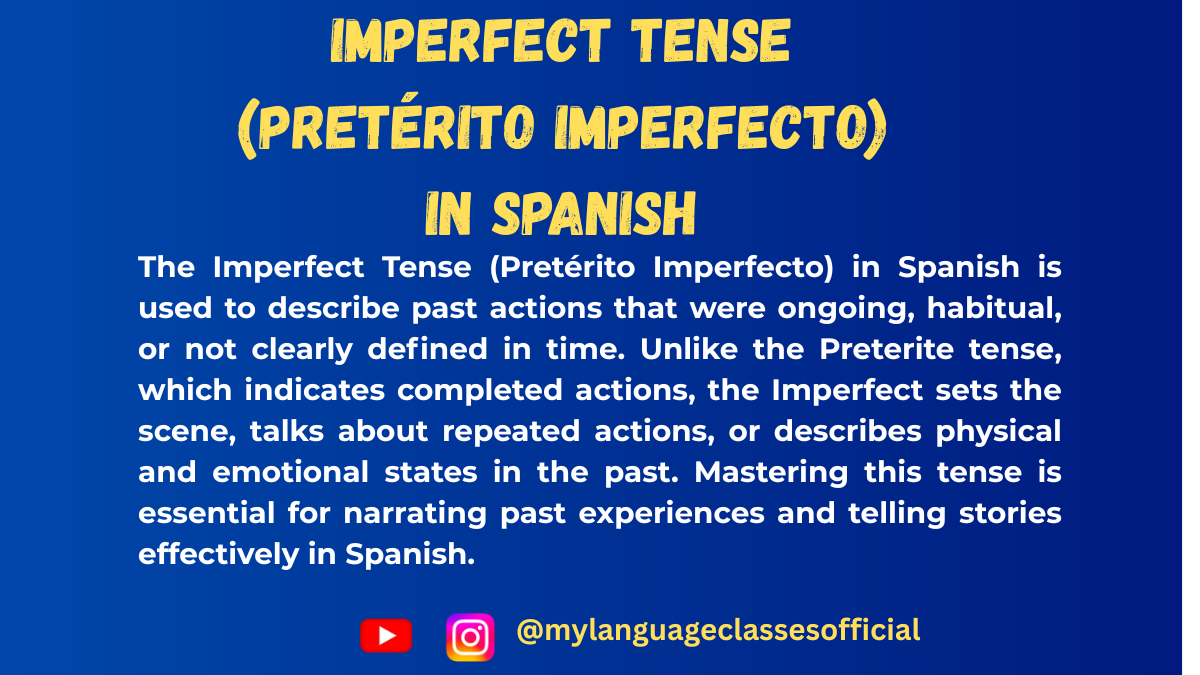
Imperfect Tense (Pretérito Imperfecto) in Spanish
Imperfect Tense (Pretérito Imperfecto)
The Pretérito Imperfecto is one of the past tenses in Spanish, used to describe habitual actions, ongoing events, and situations in the past. It provides context or background without indicating when the action specifically started or ended. Below, we’ll explore its use, conjugation for regular and irregular verbs, and common expressions.
When Do We Use the Pretérito Imperfecto?
- Describing habitual or repeated actions in the past
- Example: Cuando era niño, jugaba al fútbol todos los días.
(When I was a child, I played soccer every day.)
- Example: Cuando era niño, jugaba al fútbol todos los días.
- Setting the scene or providing background information
- Example: Hacía frío y nevaba cuando llegué a casa.
(It was cold, and it was snowing when I arrived home.)
- Example: Hacía frío y nevaba cuando llegué a casa.
- Describing mental states, emotions, or physical conditions in the past
- Example: Estaba cansado después del trabajo.
(I was tired after work.)
- Example: Estaba cansado después del trabajo.
- Actions that were in progress in the past (without focusing on their start or end)
- Example: Leía un libro mientras ella cocinaba.
(I was reading a book while she was cooking.)
- Example: Leía un libro mientras ella cocinaba.
- Telling time and age in the past
- Example: Eran las cinco de la tarde.
(It was five in the afternoon.)
Tenía veinte años en ese momento.
(I was twenty years old at that time.)
- Example: Eran las cinco de la tarde.
Forming the Pretérito Imperfecto
The conjugation of regular verbs in the imperfect tense follows specific patterns for each verb group: -ar, -er, and -ir.
Regular Verbs
- -AR VerbsSubjectEndingExample (hablar)Yo-abahablabaTú-abashablabasÉl/Ella-abahablabaNosotros-ábamoshablábamosVosotros-abaishablabaisEllos-abanhablaban
- -ER VerbsSubjectEndingExample (comer)Yo-íacomíaTú-íascomíasÉl/Ella-íacomíaNosotros-íamoscomíamosVosotros-íaiscomíaisEllos-íancomían
- -IR Verbs
Conjugation is identical to -er verbs.- Example: vivir
vivía, vivías, vivía, vivíamos, vivíais, vivían
- Example: vivir
Key Irregular Verbs in the Pretérito Imperfecto
- Ir (to go)
- Iba, ibas, iba, íbamos, ibais, iban
- Ser (to be)
- Era, eras, era, éramos, erais, eran
- Ver (to see)
- Veía, veías, veía, veíamos, veíais, veían
Things to Keep in Mind
- Articles and Gender: When describing objects or actions, make sure articles (el, la, los, las) match the noun’s gender and number. For example:
- El sol brillaba. (The sun was shining.)
- Las estrellas iluminaban el cielo. (The stars lit up the sky.)
- Context and Time Expressions: Words like siempre (always), a menudo (often), cuando era niño/a (when I was a child), mientras (while), and todos los días (every day) are often used with the imperfect tense.
Common Expressions with Pretérito Imperfecto
- Cuando era niño/a – When I was a child
- Cuando era niña, me encantaba jugar con muñecas.
(When I was a little girl, I loved playing with dolls.)
- Cuando era niña, me encantaba jugar con muñecas.
- Todos los días – Every day
- Todos los días iba a la escuela a pie.
(Every day I walked to school.)
- Todos los días iba a la escuela a pie.
- Siempre – Always
- Siempre veía la televisión después de la cena.
(I always watched TV after dinner.)
- Siempre veía la televisión después de la cena.
- A menudo – Often
- A menudo visitábamos a nuestros abuelos los domingos.
(We often visited our grandparents on Sundays.)
- A menudo visitábamos a nuestros abuelos los domingos.
- Mientras – While
- Mientras ella cocinaba, él ponía la mesa.
(While she was cooking, he was setting the table.)
- Mientras ella cocinaba, él ponía la mesa.
Common Verbs in Pretérito Imperfecto with Examples
- Hablar (to talk)
- Yo hablaba con mis amigos cada tarde.
(I used to talk with my friends every afternoon.)
- Yo hablaba con mis amigos cada tarde.
- Comer (to eat)
- Nosotros comíamos juntos todos los sábados.
(We ate together every Saturday.)
- Nosotros comíamos juntos todos los sábados.
- Vivir (to live)
- Ellos vivían en Madrid en los años 90.
(They lived in Madrid in the 90s.)
- Ellos vivían en Madrid en los años 90.
- Estar (to be)
- Él estaba feliz en esa época.
(He was happy at that time.)
- Él estaba feliz en esa época.
- Leer (to read)
- Ella leía un libro cuando la llamé.
(She was reading a book when I called her.)
- Ella leía un libro cuando la llamé.
The Pretérito Imperfecto is a versatile tense that captures the nuances of the past in Spanish. By practicing its conjugation, understanding its context, and incorporating common expressions, you’ll master its use in no time!
If you found this guide helpful, I’d love to hear from you! Share your thoughts in the comments below or connect with me on social media. For more tips, resources, and inspiration, visit my blog at mylanguageclasses.in. Follow on Instagram and subscribe on YouTube
📚 Continue Learning Spanish
- Describing habitual or repeated actions in the past
-
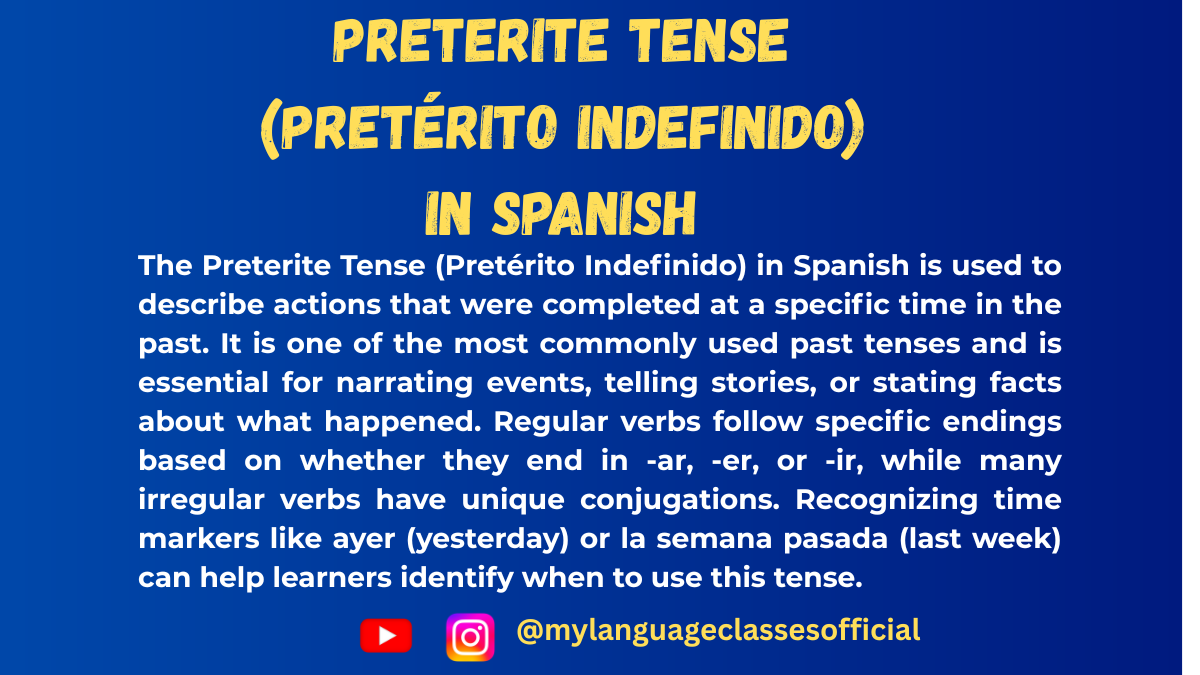
Preterite Tense (Pretérito Indefinido) in Spanish
Preterite Tense (Pretérito Indefinido) in Spanish
The Preterite tense, or Pretérito Indefinido, is one of the most common past tenses in Spanish. It’s primarily used to describe actions that were completed in the past. In this blog, we will dive deep into understanding its usage, formation, and some practical expressions to help you speak like a native.
When to Use the Preterite Tense
The Preterite is used in several specific situations:
- Completed actions in the past
Actions that are seen as finished and are not ongoing.
Example:- Ayer leí un libro. (Yesterday I read a book.)
- Actions with a clear beginning or end
Events that started and ended at a specific time.
Example:- Llegué a casa a las 8. (I arrived home at 8.)
- Sequential actions
Events that happened one after the other.
Example:- Me levanté, me duché y salí a correr. (I got up, showered, and went for a run.)
- Interrupting actions
When one action interrupts another ongoing action.
Example:- Estudiaba cuando sonó el teléfono. (I was studying when the phone rang.)
Forming the Preterite Tense
The Preterite tense has different conjugation rules for -AR, -ER, and -IR regular verbs.
Regular Verb Conjugation
- -AR Verbs
Replace the infinitive ending-arwith:- é, aste, ó, amos, asteis, aron
- Yo hablé (I spoke)
- Tú hablaste (You spoke)
- Él/Ella/Usted habló (He/She/You spoke)
- Nosotros/as hablamos (We spoke)
- Vosotros/as hablasteis (You all spoke)
- Ellos/Ellas/Ustedes hablaron (They/You all spoke)
- -ER Verbs
Replace the infinitive ending-erwith:- í, iste, ió, imos, isteis, ieron
- Yo comí (I ate)
- Tú comiste (You ate)
- Él/Ella/Usted comió (He/She/You ate)
- Nosotros/as comimos (We ate)
- Vosotros/as comisteis (You all ate)
- Ellos/Ellas/Ustedes comieron (They/You all ate)
- -IR Verbs
Replace the infinitive ending-irwith the same endings as-erverbs:- í, iste, ió, imos, isteis, ieron
- Yo viví (I lived)
- Tú viviste (You lived)
- Él/Ella/Usted vivió (He/She/You lived)
- Nosotros/as vivimos (We lived)
- Vosotros/as vivisteis (You all lived)
- Ellos/Ellas/Ustedes vivieron (They/You all lived)
Common Irregular Verbs in Preterite
Some verbs have irregular stems and endings in the Preterite. These do not follow the standard conjugation rules.
List of Common Irregular Verbs
- Ser/Ir (to be/to go): fui, fuiste, fue, fuimos, fuisteis, fueron
- Hacer (to do/make): hice, hiciste, hizo, hicimos, hicisteis, hicieron
- Estar (to be): estuve, estuviste, estuvo, estuvimos, estuvisteis, estuvieron
- Tener (to have): tuve, tuviste, tuvo, tuvimos, tuvisteis, tuvieron
- Poder (to be able to): pude, pudiste, pudo, pudimos, pudisteis, pudieron
- Decir (to say): dije, dijiste, dijo, dijimos, dijisteis, dijeron
Common Expressions with Preterite Tense
Here’s a list of expressions often used with the Preterite tense, along with their meanings and examples:
- Ayer (Yesterday)
- Example: Ayer fuimos al cine. (Yesterday we went to the cinema.)
- Anoche (Last night)
- Example: Anoche cené con mis amigos. (Last night I had dinner with my friends.)
- El año pasado (Last year)
- Example: El año pasado viajé a España. (Last year I traveled to Spain.)
- Hace un mes (A month ago)
- Example: Hace un mes terminé el curso. (A month ago I finished the course.)
- La semana pasada (Last week)
- Example: La semana pasada trabajé mucho. (Last week I worked a lot.)
- De repente (Suddenly)
- Example: De repente empezó a llover. (Suddenly it started to rain.)
- Una vez (Once)
- Example: Una vez conocí a un famoso. (Once I met a celebrity.)
Things to Keep in Mind
- Gender and Plurality
While verbs in the Preterite tense are not affected by gender or plurality, the articles and adjectives around them should agree with the noun.- Example:
- El niño habló. (The boy spoke.)
- La niña habló. (The girl spoke.)
- Example:
- Irregularities and Spelling Changes
- Verbs ending in
-car,-gar, and-zarhave spelling changes in the yo form:- Buscar → busqué
- Pagar → pagué
- Almorzar → almorcé
- Verbs ending in
- Pronunciation Tips
- Stress is crucial in the Preterite tense. For example:
- Caminó (He/She walked) vs. Camino (Road).
- Stress is crucial in the Preterite tense. For example:
Practice Makes Perfect!
Learning the Preterite tense requires practice. Try forming sentences using both regular and irregular verbs. Use the common expressions listed above to describe past events, and soon, you’ll find it much easier to recall these forms naturally.
If you found this guide helpful, I’d love to hear from you! Share your thoughts in the comments below or connect with me on social media. For more tips, resources, and inspiration, visit my blog at mylanguageclasses.in. Follow on Instagram and subscribe on YouTube
📚 Continue Learning Spanish
- Completed actions in the past
-
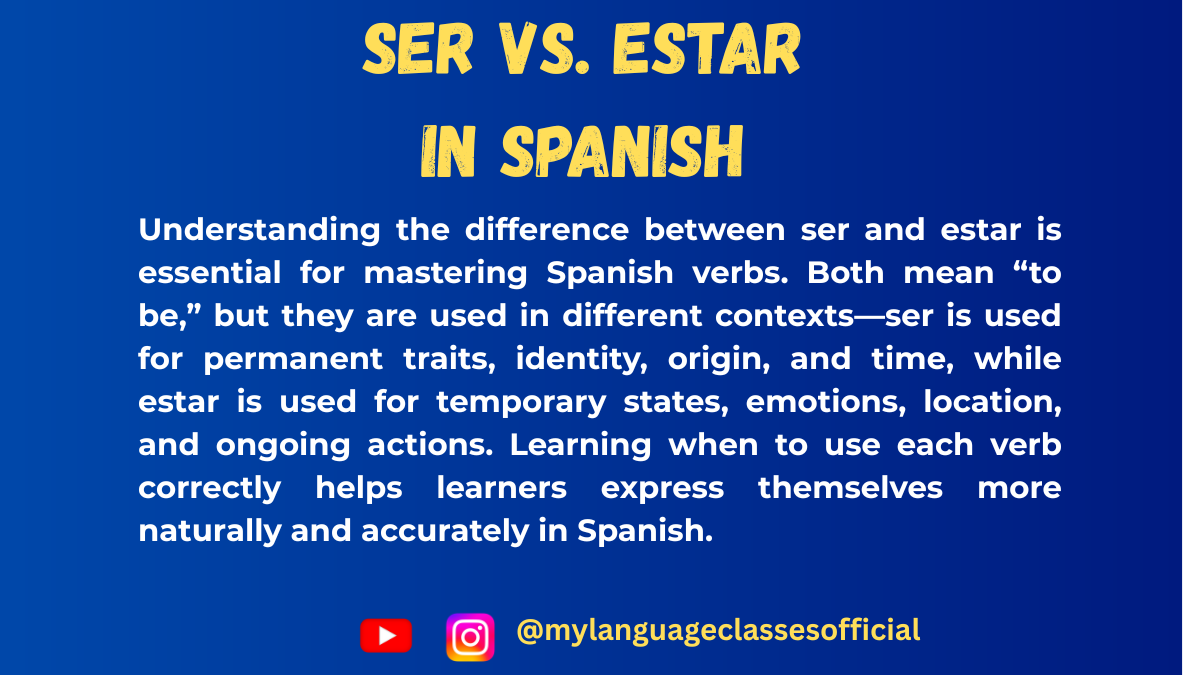
Ser vs. Estar in Spanish
Ser vs. Estar in Spanish
One of the first challenges for English speakers learning Spanish is understanding the difference between ser and estar, two verbs that both translate to “to be” in English. While they may seem interchangeable at first glance, their uses are distinct and crucial for speaking Spanish correctly.
Let’s dive into their differences, common expressions, and practical tips to master them.
The Core Difference
Ser
Ser is used to describe essential characteristics, identity, and things that are inherent or permanent.
Estar
Estar is used to describe temporary states, locations, and conditions.
When to Use Ser
- Identity & Characteristics
- To identify someone or something:
- Soy estudiante. (I am a student.)
- To describe physical or personality traits:
- Ella es alta y simpática. (She is tall and friendly.)
- To identify someone or something:
- Origin and Nationality
- To talk about where someone is from:
- Somos de México. (We are from Mexico.)
- To talk about where someone is from:
- Time and Dates
- For time expressions:
- Son las tres. (It is three o’clock.)
- For dates:
- Hoy es lunes. (Today is Monday.)
- For time expressions:
- Professions
- To state occupations:
- Él es doctor. (He is a doctor.)
- To state occupations:
- Possession
- To indicate ownership:
- Este libro es mío. (This book is mine.)
- To indicate ownership:
- Events
- To say where or when an event occurs:
- La reunión es en la oficina. (The meeting is in the office.)
- To say where or when an event occurs:
When to Use Estar
- Temporary States and Conditions
- To express emotions or physical conditions:
- Estoy feliz. (I am happy.)
- Ellos están cansados. (They are tired.)
- To express emotions or physical conditions:
- Location
- To describe where something or someone is (except events):
- El libro está en la mesa. (The book is on the table.)
- Estamos en casa. (We are at home.)
- To describe where something or someone is (except events):
- Ongoing Actions
- To form the present progressive:
- Estoy estudiando. (I am studying.)
- Están bailando. (They are dancing.)
- To form the present progressive:
- Result of Actions
- To indicate the result of a previous action:
- La ventana está abierta. (The window is open.)
- To indicate the result of a previous action:
Common Expressions Using Ser and Estar
Here’s a list of expressions frequently used in daily Spanish conversation:
Expressions with Ser
- Ser pan comido – To be a piece of cake (easy)
- Este examen es pan comido. (This exam is a piece of cake.)
- Ser un/a cabezota – To be stubborn
- Eres un cabezota. (You are stubborn.)
- Ser buena/mala gente – To be a good/bad person
- Mi abuela es buena gente. (My grandmother is a good person.)
- Ser el colmo – To be the last straw
- ¡Esto es el colmo! (This is the last straw!)
Expressions with Estar
- Estar de acuerdo – To agree
- ¿Estás de acuerdo? (Do you agree?)
- Estar en las nubes – To be daydreaming
- Hoy estás en las nubes. (Today you are daydreaming.)
- Estar de buen/mal humor – To be in a good/bad mood
- Estoy de buen humor. (I’m in a good mood.)
- Estar hasta las narices – To be fed up
- Estoy hasta las narices de esto. (I’m fed up with this.)
Tips for Mastering Ser and Estar
- Context is Key
Always ask yourself: Is this describing a permanent trait (ser) or a temporary state (estar)? - Gender and Plurality Agreement
Both ser and estar must agree with the subject in gender and number:- Ella es inteligente. (She is intelligent.)
- Ellos están contentos. (They are happy.)
- Articles and Adjectives
When describing something, ensure articles (e.g., el, la, los, las) and adjectives agree with the subject:- La casa es grande. (The house is big.)
- Las puertas están cerradas. (The doors are closed.)
- Practice Set Phrases
Memorizing idiomatic expressions with ser and estar will help you sound natural.
Example Sentences
- Ser
- Mi hermano es médico. (My brother is a doctor.)
- El cielo es azul. (The sky is blue.)
- Estar
- La comida está fría. (The food is cold.)
- Estoy en el parque. (I am in the park.)
By mastering the nuances of ser and estar, you’ll be able to express yourself with clarity and confidence in Spanish. Keep practicing, and soon these distinctions will feel natural!
If you found this guide helpful, I’d love to hear from you! Share your thoughts in the comments below or connect with me on social media. For more tips, resources, and inspiration, visit my blog at mylanguageclasses.in. Follow on Instagram and subscribe on YouTube
📚 Continue Learning Spanish
- Identity & Characteristics
-
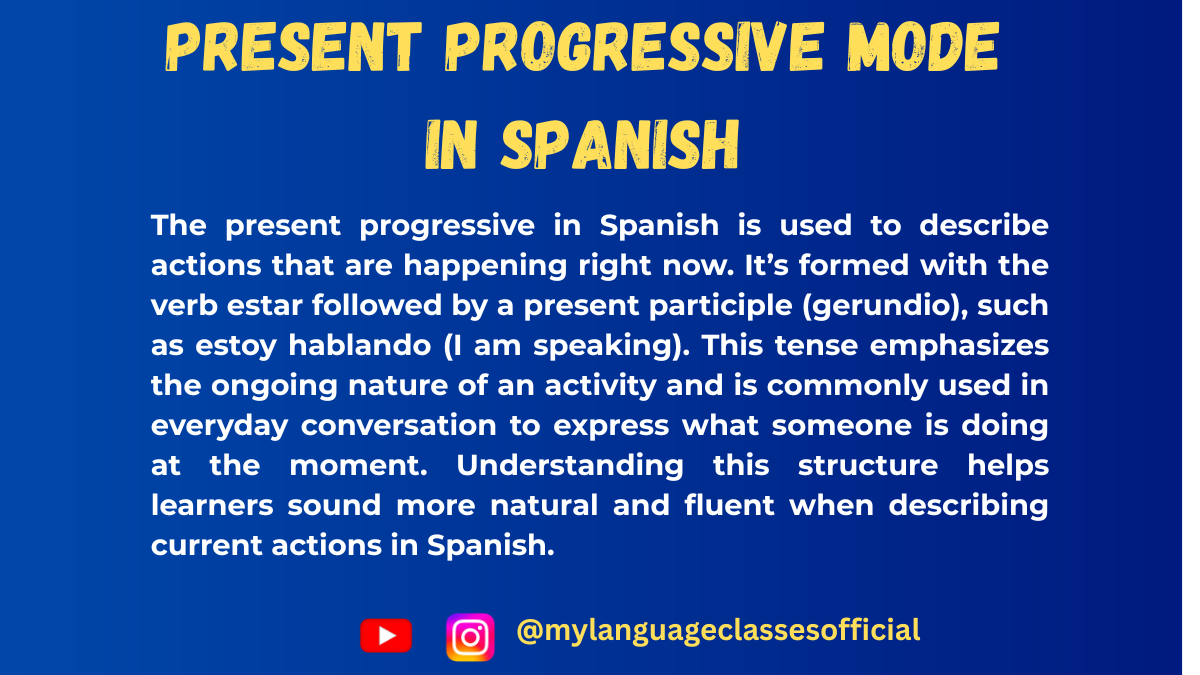
Present Progressive in Spanish
Mastering Present Progressive in Spanish
The present progressive tense (or continuous tense) is one of the most practical and dynamic structures in Spanish. It’s the equivalent of the English “present continuous” tense and is used to describe actions happening right now. If you’ve ever said something like “I am studying” in English, you’ve used a structure similar to Spanish: “Estoy estudiando.”
In this guide, you’ll learn what the present progressive is, how to form it correctly, when to use it, common irregularities, and common mistakes to avoid. Let’s dive in!
What is the Present Progressive?
The present progressive is used to describe actions that are happening right now. It combines the verb estar (to be) as an auxiliary with another verb in its gerund form.
For example:
- Estoy escribiendo (I am writing).
- Estamos aprendiendo español (We are learning Spanish).
How to Form the Present Progressive
1. Conjugate the Verb “Estar”
First, conjugate estar in the present tense according to the subject. Here’s a quick review:
Subject Conjugation of “Estar” Yo estoy Tú estás Él/Ella/Usted está Nosotros/as estamos Vosotros/as estáis Ellos/Ellas/Ustedes están 2. Add the Gerund Form of the Main Verb
The gerund (or present participle) is formed by adding -ando to the stem of -ar verbs and -iendo to the stem of -er and -ir verbs.
Verb Type Example Verb Gerund Form Example -AR Hablar Hablando Estoy hablando (I am speaking). -ER Comer Comiendo Estás comiendo (You are eating). -IR Vivir Viviendo Ellos están viviendo (They are living).
Irregularities in Present Progressive Formation
While most verbs follow the standard -ando/-iendo pattern, some verbs have irregular gerund forms. These can be categorized based on their unique characteristics:
1. Verbs with Spelling Changes
Some verbs change spelling in the gerund to maintain proper pronunciation or avoid awkward letter combinations.
Verb Gerund Form Example Leer Leyendo Estoy leyendo (I am reading). Construir Construyendo Están construyendo (They are building). Oír Oyendo Está oyendo (He/She is hearing). Caer Cayendo Estoy cayendo (I am falling).
2. Stem-Changing Verbs in -IR
Stem-changing verbs that end in -ir modify their stem vowel in the gerund form. These changes occur in verbs that have e → i or o → u shifts in the present tense.
Verb Gerund Form Example Dormir Durmiendo Estoy durmiendo (I am sleeping). Morir Muriendo Está muriendo (He/She is dying). Servir Sirviendo Están sirviendo (They are serving). Pedir Pidiendo Estoy pidiendo (I am requesting).
3. Irregular Verbs with Unique Forms
Certain highly irregular verbs have gerunds that do not follow standard rules.
Verb Gerund Form Example Ir Yendo Estoy yendo (I am going). Poder Pudiendo Está pudiendo (He/She is able to). Venir Viniendo Estamos viniendo (We are coming).
When to Use the Present Progressive
Use the present progressive when describing actions that are happening right now or in the immediate present. Examples include:
- ¿Qué estás haciendo? (What are you doing?)
- Estoy estudiando para un examen. (I am studying for a test.)
- Estamos trabajando en un proyecto. (We are working on a project.)
Common Mistakes to Avoid
- Overusing the Present Progressive In Spanish, the simple present tense is often used instead of the present progressive for habitual actions or near-future events. For example:
- English: I am going to the store tomorrow.
- Correct Spanish: Voy a la tienda mañana. (Not Estoy yendo a la tienda mañana.)
- Incorrect Gerund Formation Remember the spelling and stem changes discussed above. For example:
- Incorrect: Están leiendo.
- Correct: Están leyendo.
- Forgetting to Conjugate “Estar” Always ensure that estar matches the subject of the sentence. For example:
- Incorrect: Ellos está comiendo.
- Correct: Ellos están comiendo.
Practice Exercises
Try these sentences and check your understanding:
- I am listening to music. → (Translate to Spanish)
- We are running in the park. → (Translate to Spanish)
- What are you writing? → (Translate to Spanish)
Conclusion
The present progressive is an essential tool for Spanish learners, especially when you want to describe ongoing actions. By mastering estar + gerundio and learning how to handle irregular verbs, you’ll speak Spanish with greater fluency and confidence. Practice regularly, and don’t be afraid to make mistakes—they are part of the learning process!
¿Qué estás esperando? (What are you waiting for?) Start using the present progressive in your Spanish conversations today!
If you found this guide helpful, I’d love to hear from you! Share your thoughts in the comments below or connect with me on social media. For more tips, resources, and inspiration, visit my blog at mylanguageclasses.in. Follow on Instagram and subscribe on YouTube
📚 Continue Learning Spanish
-
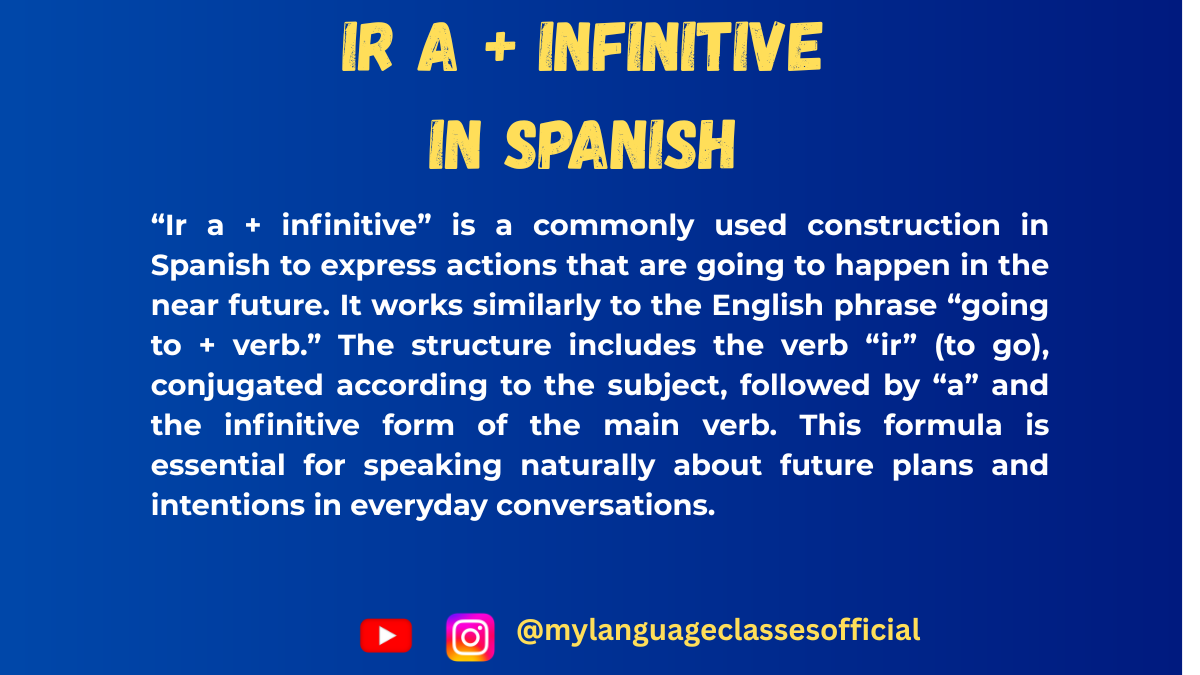
Near Future Tense in Spanish: Mastering Ir a + Infinitive
Near Future Tense in Spanish: Mastering Ir a + Infinitive
If you’re learning Spanish, you’ve likely encountered the phrase voy a estudiar (“I’m going to study”). This construction is an example of the near future tense, a simple and versatile way to talk about events that are going to happen soon. Today, we’ll explore how to use this tense, why it’s so practical, and how it compares to other future forms in Spanish. Let’s dive in!
What is the Near Future Tense?
The near future tense in Spanish uses the verb ir (to go), followed by the preposition a and an infinitive verb. It’s similar to the English construction “to be going to + verb.” For example:
- Voy a bailar. – I’m going to dance.
- Vamos a comer. – We’re going to eat.
- Ellos van a viajar. – They’re going to travel.
This structure is widely used in everyday conversation because it’s straightforward and easy to learn.
How to Form the Near Future Tense
The formula is simple:
[Conjugated form of ir] + a + [infinitive verb]Here’s how you conjugate ir in the present tense:
Subject Pronoun Conjugation of ir Yo voy Tú vas Él/Ella/Usted va Nosotros/as vamos Vosotros/as vais Ellos/Ellas/Ustedes van Once you’ve got ir conjugated, just add a and any infinitive verb:
- Voy a leer. – I’m going to read.
- ¿Vas a escribir? – Are you going to write?
- Ellos van a salir. – They are going to go out.
Why Use the Near Future Tense?
The ir a + infinitive construction is perfect for beginners because it’s less complicated than the simple future tense (hablaré, comerás, vivirán). It’s also highly practical—it allows you to talk about immediate plans or intentions without needing to learn additional verb conjugations.
For example:
- Instead of saying Estudiaré mañana (I will study tomorrow), you can say Voy a estudiar mañana (I’m going to study tomorrow).
- Both are correct, but voy a estudiar feels more conversational and is commonly used in informal settings.
Examples of Near Future in Everyday Situations
- Making Plans
- ¿Qué vas a hacer esta tarde? – What are you going to do this afternoon?
- Voy a ir al cine. – I’m going to go to the movies.
- Expressing Intentions
- Vamos a aprender mucho hoy. – We’re going to learn a lot today.
- Voy a ayudar a mi mamá. – I’m going to help my mom.
- Asking Questions
- ¿Vas a venir a la fiesta? – Are you going to come to the party?
- ¿Van a preparar la cena? – Are they going to prepare dinner?
Tips for Mastering the Near Future Tense
- Practice with Everyday Activities: Make a list of what you’re planning to do tomorrow and describe it using ir a + infinitive. For example, Voy a trabajar. Voy a estudiar. Voy a descansar.
- Combine with Time Expressions: Adding time markers helps specify when the action will happen. For example:
- Voy a salir mañana. – I’m going to go out tomorrow.
- Vamos a viajar en verano. – We’re going to travel in summer.
- Roleplay Common Scenarios: Imagine planning a weekend trip, a day at work, or a family gathering. Use phrases like Voy a comprar comida (I’m going to buy food) or Vamos a visitar a nuestros amigos (We’re going to visit our friends).
Comparison with the Simple Future
While the ir a + infinitive construction is easy and practical, the simple future tense (-é, -ás, -á, -emos, -éis, -án) is also important to learn for more formal or distant future events. For example:
- Voy a estudiar español. – I’m going to study Spanish (soon or in the near future).
- Estudiaré español en la universidad. – I will study Spanish at university (a more formal or distant future).
Conclusion
The ir a + infinitive construction is an essential tool for Spanish learners. It’s simple, flexible, and widely used in real-life conversations. By mastering this tense, you’ll be able to express your plans and intentions with confidence.
So, what are you going to do next? (¿Qué vas a hacer ahora?) Practice using this tense, and you’ll see how quickly it becomes a natural part of your Spanish conversations.
¡Buena suerte! 📝
If you found this guide helpful, I’d love to hear from you! Share your thoughts in the comments below or connect with me on social media. For more tips, resources, and inspiration, visit my blog at mylanguageclasses.in. Follow on Instagram and subscribe on YouTube
📚 Continue Learning Spanish

